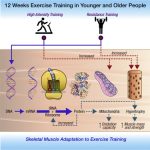High Intensity Interval Training (HIIT) rejuvenates aging cells shows new study.
Mitochondrial activity decreases as we age. So much so that many theories of aging are centered around the tiny energy factories within our cells. The reduction in efficiency contributes to frailty, self-reported fatigue, slower movement and other age related morbidity such as diabetes. A new study entitled “Enhanced Protein Translation Underlies Improved Metabolic and Physical Adaptations to Different Exercise Training Modes in Young and Old Humans” in the journal Cell Metabolism has shown that this process has some reversible elements.
“Robinson et al. assessed the effects of three different exercise modalities on skeletal muscle adaptations in young and older adults. While all enhanced insulin sensitivity, only HIIT and combined training improved aerobic capacity, associated with enhanced translation of mitochondrial proteins. HIIT effectively improved cardio-metabolic health parameters in aging adults.”
HIIT training involves performance of a short burst of high-intensity (exercise followed by a brief low-intensity activity, repeatedly, until point of exhaustion. Though there is no universal HIIT session duration, these intense workouts typically last under 30 minutes, with times varying based on a participant’s current fitness level.
In this study participants were recruited into two distinct age groups: young (18–30 years) or older (65–80 years). They were then randomized into three groups (HIIT, Resistance Training (RT), or Cardio Training). HIIT was 3 days per week of cycling (4, 3, 4, min at >90% of peak oxygen consumption with 3 min pedaling at no load) and 2 days per week of treadmill walking (45 min at 70% of VO2 peak). RT consisted of lower and upper body exercises (4 sets of 8–12 repetitions) 2 days each per week. CT participants first underwent a 12-week sedentary period (SED) and then began 5 days per week cycling (30 min at 70% VO2 peak) and 4 days per week weight lifting with fewer repetitions than RT.

The headline outcome was that after 3 months of HIIT the mitochondrial energy production increased by 69% in older participants and 49% in younger participants. No gain in mitochondrial function was seen in the RT or CT groups however they did have their own benefits.
Do you use HIIT with your treatment of over 65’s? Let us know in the comments below or via social media.